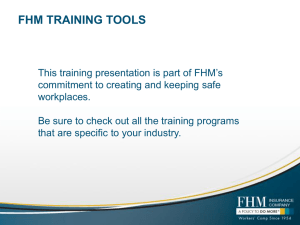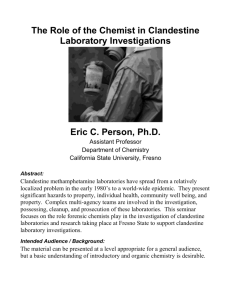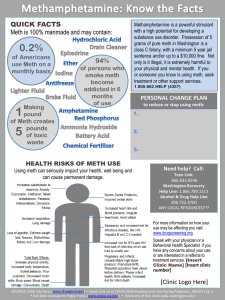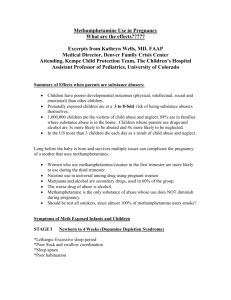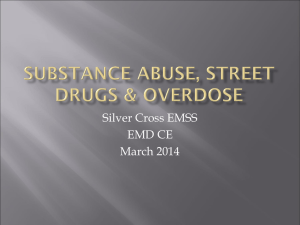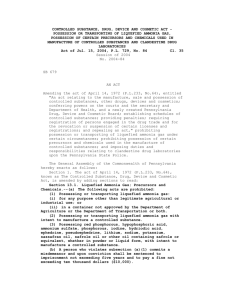Drug Lab Information
advertisement
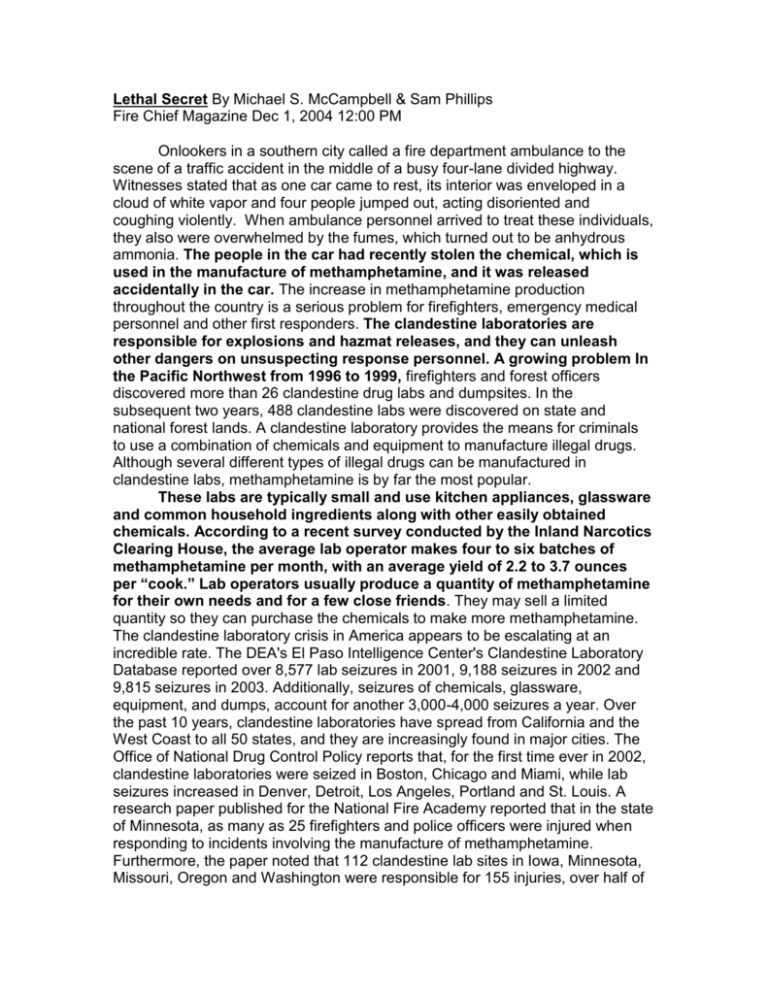
Lethal Secret By Michael S. McCampbell & Sam Phillips Fire Chief Magazine Dec 1, 2004 12:00 PM Onlookers in a southern city called a fire department ambulance to the scene of a traffic accident in the middle of a busy four-lane divided highway. Witnesses stated that as one car came to rest, its interior was enveloped in a cloud of white vapor and four people jumped out, acting disoriented and coughing violently. When ambulance personnel arrived to treat these individuals, they also were overwhelmed by the fumes, which turned out to be anhydrous ammonia. The people in the car had recently stolen the chemical, which is used in the manufacture of methamphetamine, and it was released accidentally in the car. The increase in methamphetamine production throughout the country is a serious problem for firefighters, emergency medical personnel and other first responders. The clandestine laboratories are responsible for explosions and hazmat releases, and they can unleash other dangers on unsuspecting response personnel. A growing problem In the Pacific Northwest from 1996 to 1999, firefighters and forest officers discovered more than 26 clandestine drug labs and dumpsites. In the subsequent two years, 488 clandestine labs were discovered on state and national forest lands. A clandestine laboratory provides the means for criminals to use a combination of chemicals and equipment to manufacture illegal drugs. Although several different types of illegal drugs can be manufactured in clandestine labs, methamphetamine is by far the most popular. These labs are typically small and use kitchen appliances, glassware and common household ingredients along with other easily obtained chemicals. According to a recent survey conducted by the Inland Narcotics Clearing House, the average lab operator makes four to six batches of methamphetamine per month, with an average yield of 2.2 to 3.7 ounces per “cook.” Lab operators usually produce a quantity of methamphetamine for their own needs and for a few close friends. They may sell a limited quantity so they can purchase the chemicals to make more methamphetamine. The clandestine laboratory crisis in America appears to be escalating at an incredible rate. The DEA's El Paso Intelligence Center's Clandestine Laboratory Database reported over 8,577 lab seizures in 2001, 9,188 seizures in 2002 and 9,815 seizures in 2003. Additionally, seizures of chemicals, glassware, equipment, and dumps, account for another 3,000-4,000 seizures a year. Over the past 10 years, clandestine laboratories have spread from California and the West Coast to all 50 states, and they are increasingly found in major cities. The Office of National Drug Control Policy reports that, for the first time ever in 2002, clandestine laboratories were seized in Boston, Chicago and Miami, while lab seizures increased in Denver, Detroit, Los Angeles, Portland and St. Louis. A research paper published for the National Fire Academy reported that in the state of Minnesota, as many as 25 firefighters and police officers were injured when responding to incidents involving the manufacture of methamphetamine. Furthermore, the paper noted that 112 clandestine lab sites in Iowa, Minnesota, Missouri, Oregon and Washington were responsible for 155 injuries, over half of which were to first responders, firefighters, EMTs, hospital personnel and police officers. The two major methods of manufacturing methamphetamine are variations of the ephedrine reduction process: the red phosphorus method, known as “red P,” and the lithium or sodium reduction method, known as “Nazi dope” or “Birch.” As a starting point, both processes use ephedrine or pseudoephedrine, which are commonly found in cold and allergy tablets. Two other chemicals used in the red phosphorus method are black iodine and red phosphorus. Although this method doesn't require heat because the exothermic reaction of the chemical combination creates its own heat, most lab operators add heat to speed up the manufacturing. The entire cooking process usually takes from four to six hours. The Nazi dope method commonly uses a mixture of lithium strips from camera batteries and anhydrous ammonia, in addition to ephedrine or pseudoephedrine. Anhydrous ammonia is a liquid fertilizer found predominantly in agricultural areas. Because it is maintained under high pressure as a liquid and is dangerous to handle, lab operators usually steal anhydrous ammonia from farm storage tanks just before they are ready to cook. An outside heat source is not needed for the Nazi dope process. Clandestine laboratories often contain Mason or Ball canning jars, rubber tubing, sports drink bottles, coffee filters, gasoline cans, hot plates, Pyrex or Corningware cooking dishes, pails and buckets, propane cylinders, laboratory grade beakers and glassware, ice chests, measuring cups, aluminum foil, rubber gloves, thermometers, and turkey basters. Chemicals commonly found at illicit labs include ether, toluene, sulfuric acid (Liquid Fire or similar-brand drain cleaner), sodium hydroxide (Red Devil Lye, Drano or similar brand), hydrochloric acid, muriatic acid, anhydrous ammonia, lithium strips, matches, cat litter, red phosphorus, black iodine, alcohol, rock salt or table salt, and acetone. Twenty-eight firefighters from a Midwestern community battled a structural fire for hours after ignition in a suspected clandestine drug laboratory. One man, one woman and three children were transported to a medical facility for burn treatment. In addition, two paramedics, one firefighter and eight citizens were treated for inhalation of fumes and minor burns. According to published reports, firefighters had responded to the same location one week earlier for a report of smoke in the structure. Methamphetamine production methods can be extremely dangerous. Toxic fumes, corrosive chemicals and poisonous gas pose extreme risks, both short- and long-term, to emergency personnel. The chemicals used to manufacture methamphetamine create a potentially lethal situation for anyone stumbling on a clandestine laboratory, especially if a cook is in progress. According to the Centers for Disease Control and Prevention, clandestine laboratories were responsible for injuries to 79 emergency responders in 14 states between 1996 and 1999. During an in-progress cook using the red phosphorus method, there's a danger of fire, explosion and release of toxic gases. For example, many lab operators use extremely volatile chemicals such as methanol and ether. When used in combination with a heat source, fumes from these chemicals can ignite and/or explode. In one Colorado lab fire, firefighters discovered that camping fuel spilled on the floor ignited, killing two women and injuring two men. Electricity in the house was supplied by extension cords spliced together and illegally rigged to the electric meter. In addition, fumes from these and other substances present in a lab, such as red phosphorus and black iodine, are poisonous. One major hazard to be considered in this type of lab is the possible presence of phosphine gas, which occurs when the process gets too hot or is allowed to cook dry. This gas is highly unstable and very poisonous. Another hazard is caused by burning red phosphorus, which generates a toxic smoke containing phosphoric acid. If this smoke is inhaled, the acid can burn the lungs and result in chemical pneumonia. Also, when red phosphorus is overheated, it can transform into white phosphorus, which may auto-ignite if it comes in contact with water. An extremely hazardous condition that also may be found during a red phosphorus meth cook is the presence of hydrogen chloride gas, which is formed when common salt and sulfuric acid from household drain openers are combined to extract the finished methamphetamine from a base solution. Hydrogen chloride gas is extremely dangerous and can cause permanent injury to lungs and mucous membranes. One of the most dangerous hazards that may be found during this process is the presence of ether, which has been extracted from cans of automotive starting fluid. Ether is extremely unstable and explosive in this form. Other possible hazards include lye, alcohol or methanol from gasoline anti-freeze containers, camping fuel, and paint thinner such as toluene and acetone. These substances are all dangerous to breathe and flammable or explosive. The Nazi dope method of methamphetamine production has its own inherent dangers, which may include the presence of ether, alcohol, lye, camping fuel and other chemicals such as acids. The presence of hydrogen chloride gas is also a danger during this process because lab operators use salt and sulfuric acid or other acids such as hydrochloric or muriatic acid to extract the finished methamphetamine. Two hazards are specific to this process: anhydrous ammonia and lithium. Lithium strips, which usually are extracted from camera batteries, can ignite if they come in contact with water. They must be stored in mineral spirits or kerosene after they are removed from the camera batteries. Anhydrous ammonia, which means ammonia without water, is extremely dangerous. Because of its chemical nature, anhydrous ammonia seeks water from the nearest source, including human skin. The eyes, lungs and skin are at risk because of their high moisture content. Caustic burns result when anhydrous ammonia dissolves into body tissue. Although contact with liquid anhydrous ammonia can cause serious chemical burns to the skin because it is very caustic, most deaths from this chemical are caused by severe damage to the throat and lungs. There's also the danger of improper tanks, such as barbecue propane tanks, used to illegally store anhydrous ammonia. The fittings on these tanks may be corroded and suffer a violent release of the anhydrous ammonia. The tanks also may explode if the outside temperature rises, causing pressure inside the tank to build, or if the ammonia eats through the tank. Even if first responders enter a meth lab site where a cook isn't in progress, there still may be hazards present if the location has been used to manufacture the drug. Household walls, carpets and other surfaces may be contaminated from fumes generated during the manufacturing process. In addition, each cook generates from five to seven pounds of hazardous waste for each pound of finished product. This waste may be anywhere inside the house, in the trash, or simply dumped outside on the ground. Lab operators like to store and reuse some of their chemicals, such as acetone, which may be stored in the kitchen freezer. Contaminated surfaces, hazardous waste and stored chemicals all can be hazardous under the right conditions, such as confined spaces, leaking containers or near an open flame. Dump sites that contain large amounts of hazardous waste from methamphetamine labs are inherently dangerous due to the presence of chemicals that may be present. Reactions that release toxic fumes or explosive gasses may resume when emergency service personnel handle or move equipment and waste found at dump sites. First responders should be aware of the human factor as a hazard. This hazard can be broken down into chronic meth abusers, “bad guys with guns” and booby traps. The effects of methamphetamine abuse include addiction, psychotic behavior and brain damage. Individuals who chronically abuse meth may have episodes of violent behavior, paranoia, anxiety, confusion and insomnia. Users also can exhibit psychotic behavior such as auditory hallucination, mood disturbances, delusion and paranoia, possibly resulting in homicidal behavior. Damage to the brain caused by methamphetamine abuse is similar to that caused by Alzheimer's disease, stroke and epilepsy. Meth abusers who inject the drug are exposed to additional risks such as HIV, hepatitis B and C, and other bloodborne pathogens. Users trying to kick the habit may suffer withdrawal symptoms that include depression, anxiety, fatigue, paranoia, aggression and intense cravings for the drug. The most dangerous stage of the drug-taking binge cycle is known as “tweaking.” During this stage, the abuser doesn't sleep for three to 15 days and is irritable and paranoid. The tweaker has an intense craving for more meth, but taking more of the drug can't increase the high. The body's ability to react to more stimulation is depleted, and this causes frustration and a potential for violence. Bad guys with guns also are a very real hazard to personnel who come in contact with meth labs or meth abusers. Anecdotal information from law enforcement officers who primarily work meth lab enforcement indicates that most lab operators have one or more firearms at their lab site. First responders should be aware that lab operators and chronic meth abusers may be armed and, at the same time, mentally unstable and dangerous. Finally, first responders should be alert for booby traps at methamphetamine labs. In one incident, firefighters and EMTS were asked to stand by in a Midwestern city while police conducted a raid on a suspected meth lab. Just as police entered the private residence, an explosion occurred and the building was engulfed in flames. Firefighters put out the blaze, and luckily nobody was hurt. An investigation by the fire marshal concluded that the fire probably was the result of a booby trap placed at the house's front entrance. These devices are designed to protect the lab operator's cook site while it's unoccupied. There may be concealed holes in the floor, spring devices with nails, pipe bombs, acid containers propped over doorways, hand grenades rigged to explode when doors are opened, acid jars and other ingenious devices. Lab operators also have been known to keep large snakes and attack dogs for defense. Based on the hazards inherent to meth labs and the dangers for first responders, the following recommendations can help emergency services administrators address these dangers. Methamphetamine labs are too hazardous to allow firefighters and EMTs to continue responding to them without essential knowledge of the dangers. All emergency response personnel should receive pre-service and in-service training on this critical issue. Training topics should include: * Clandestine laboratory hazard recognition. * Methamphetamine manufacturing methods, chemicals and equipmentm * Law enforcement procedures for shutting down a clandestine lab and decontaminating arrestees. * Symptoms of methamphetamine abuse. * Emergency protocols for handling meth abusers. There are a number of federal, state and local programs to address the training issue. Fire chiefs should make every effort to identify programs such as this and provide the necessary training to their personnel. Once personnel are properly trained, they need to be aware of the special response procedures required for suspected clandestine drug laboratories. It's important for personnel to be aware of the signs of a potential meth lab before entry is made. Proper personal protective equipment also is an important consideration. Decontamination procedures need to be thought out carefully in advance of entry, and if a drug lab is suspected, local police should be contacted and the area secured. If an active meth lab is found upon entry to a structure or a vehicle, alert other on-scene responders immediately. Don't touch anything, including light switches or electrical appliances. Back out immediately and make mental notes of what's in the lab, such as containers, glassware, other equipment and chemicals. Fire personnel should follow standardized safety precautions and guidelines, such as: Approach cautiously from upwind. Resist the urge to rush in. Others can't be helped until the situation has been assessed fully. Secure the scene. Without entering the immediate hazard area, isolate the area and ensure the safety of people and the environment. Keep people away from the scene and outside the safety perimeter. Allow enough room to move and remove your own equipment. Don't let individuals leave the scene of a suspected meth lab. The police will want to speak with them. Identify hazards. Evaluate available information and consult the recommended guide to reduce immediate risks. Remember, clandestine-lab operators may have removed dangerous substances from their original containers and placed them in unsafe, unlabeled ones. Assess the situation, asking: * Is there a fire, spill, or a leak? * What are the weather conditions? * What is the terrain or structure like? * Is evacuation necessary? * Is diking necessary? * What human and equipment resources are required and readily available? * What can be done immediately? Obtain help. Advise dispatch to notify responsible agencies and call for assistance from qualified personnel. It's especially important to immediately contact the police if you think you have discovered a meth lab. Decide on site entry. Any efforts made to rescue persons, property or the environment, must be weighed against the possibility that first response personnel may become part of the problem, either overcome by fumes, injured in an explosion or fire, or even attacked by a lab operator. Respond appropriately. Establish a command post and lines of communication. Rescue casualties where possible and evacuate if necessary. Maintain control of the site and be prepared to decontaminate all personnel, including suspected lab operators. Above all, do not walk into or touch spilled material — consider it hazardous waste. Avoid inhalation of fumes, smoke and vapors. Do not assume that gases or vapors are harmless because of lack of smell. For first responders who come upon a methamphetamine lab first and can identify it as such, consideration should be given to treating the scene as a hazmat incident and involving the hazmat team. In addition, law enforcement should be notified immediately. Every fire agency should develop policies and procedures that will assist personnel, especially line firefighters and medics, in responding to a suspected clandestine lab site. Clear procedures that address actions to be taken and not taken by first responders should be a top priority. In addition, SOPS should be developed to guide supervisory, management and hazmat personnel during all phases of any agency activity involving a suspected lab. Fire administrators should consider developing a memorandum of understanding with their local law enforcement agency that clearly delineates roles and responsibilities when a suspected methamphetamine lab is discovered. Special emphasis should be placed on development of a standardized procedure for dealing with children found at a lab. The nation's clandestine laboratory crisis is increasing because methamphetamine is in high demand and remains easy to manufacture. As the number of clandestine laboratories increase, so will the number of fires, explosions and other incidents associated with them. Fire chiefs should recognize that they have an important role to play in avoiding hazards from clandestine laboratories. Proactive policies and procedures that address these issues in advance will go a long way toward increasing the safety of emergency response personnel.
